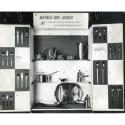Currently indexing
Table knife
Classification(s):
Metal
Date: 1957
Organisation: A.Michelsen (Danish)
Designer: Arne Jacobsen (Denmark, 1902 - 1971)
Dimensions:
200 × 16 mm (20 × 1.6 cm)
Medium: Stainless steel
Object number: CC063
See Also
Place of Production:Denmark
DescriptionStainless steel table knife designed by Arne Jacobsen for A. Michelsen, of Denmark in 1957. The knife is part of the ‘660’ flatware cutlery range. The maker’s mark is impressed on the reverse “A.Michelsen Stainless Denmark”.
The futuristic, minimalist style of the '660' range meant it was selected for use on board the spacecraft in Stanley Kubrick's 1968 science-fiction film '2001: A Space Odyssey'.
The individual pieces in the set are represented in the collection: coffee spoon (CC013 and M129), soup spoon (CC059), dessert spoon (CC060), salad knife (CC061), salad fork (CC062) and table fork (CC064).
The futuristic, minimalist style of the '660' range meant it was selected for use on board the spacecraft in Stanley Kubrick's 1968 science-fiction film '2001: A Space Odyssey'.
The individual pieces in the set are represented in the collection: coffee spoon (CC013 and M129), soup spoon (CC059), dessert spoon (CC060), salad knife (CC061), salad fork (CC062) and table fork (CC064).
ProvenanceThis object was originally acquired for the Inner London Education Authority’s (ILEA) ‘Circulating Design Scheme’ collection.
The collection was instigated by the London Country Council (later the Greater London Council) and the Council of Industrial Design (COID). The collection’s original purpose was concerned with the teaching and dissemination of modern, ‘good design’.
The collection was established in 1951/52 as the ‘Experiment in Design Appreciation’, later renamed the ‘Circulating Design Scheme’.
The Circulating Design Scheme lent boxed showcases to London schools. The showcases contained handling objects, material samples and interpretation on a specific subject.
COID withdrew its involvement in the Scheme in 1957. After which time, it was managed exclusively by the London County Council from 1957-1963.
After the administrative restructuring of London authorities, the Scheme was jointly managed by the Greater London Council and the Inner London Education Authority (ILEA) from 1963 – 1976.
The Scheme was operational until 1976 when the collections were withdrawn from circulation. ILEA was abolished in the late 1980s and the collection was donated to Camberwell College of Arts in 1989/90.
ILEA was responsible for secondary and tertiary education in the inner London boroughs, this included Camberwell.
The collection was instigated by the London Country Council (later the Greater London Council) and the Council of Industrial Design (COID). The collection’s original purpose was concerned with the teaching and dissemination of modern, ‘good design’.
The collection was established in 1951/52 as the ‘Experiment in Design Appreciation’, later renamed the ‘Circulating Design Scheme’.
The Circulating Design Scheme lent boxed showcases to London schools. The showcases contained handling objects, material samples and interpretation on a specific subject.
COID withdrew its involvement in the Scheme in 1957. After which time, it was managed exclusively by the London County Council from 1957-1963.
After the administrative restructuring of London authorities, the Scheme was jointly managed by the Greater London Council and the Inner London Education Authority (ILEA) from 1963 – 1976.
The Scheme was operational until 1976 when the collections were withdrawn from circulation. ILEA was abolished in the late 1980s and the collection was donated to Camberwell College of Arts in 1989/90.
ILEA was responsible for secondary and tertiary education in the inner London boroughs, this included Camberwell.
NotesThis object was circulated to London schools as part of the Inner London Education Authority’s (I.L.E.A) Circulating Design Scheme, which operated from 1951-1976. The Arne Jacobsen cutlery featured in the ‘Metals are joined by…’ group in case number 2. The boxed showcase describes the different manufacturing techniques for joining metals, including examples of riveting, screwing, bolting, soldering, brazing and welding. The original supplier from whom this object was acquired is unknown. The associated record card indicates the boxed showcase was in use from 1969-74. Original photograph of boxed showcase copyright Tessa Grimshaw, London.
Arne Jacobsen is thought of as one of Denmark's most influential architects and designers. He was educated at the Royal Danish Academy of Fine Arts, School of Architecture in Copenhagen, and later became a professor at the school. Having designed private houses and winning architectural commissions, Jacobsen became increasingly interested in product design. Jacobsen’s Model 3107 - Series 7 Chair is one of the most popular chair designs of the 20th and 21st century.
Arne Jacobsen is thought of as one of Denmark's most influential architects and designers. He was educated at the Royal Danish Academy of Fine Arts, School of Architecture in Copenhagen, and later became a professor at the school. Having designed private houses and winning architectural commissions, Jacobsen became increasingly interested in product design. Jacobsen’s Model 3107 - Series 7 Chair is one of the most popular chair designs of the 20th and 21st century.








